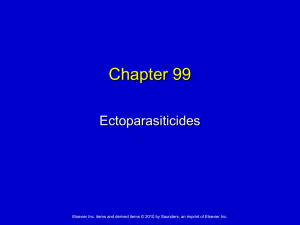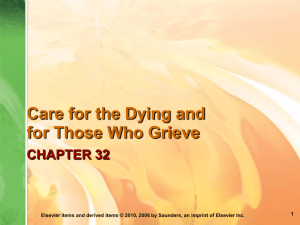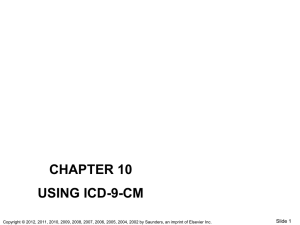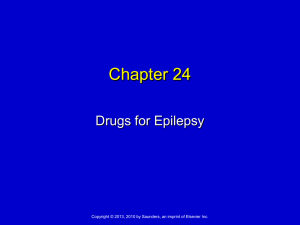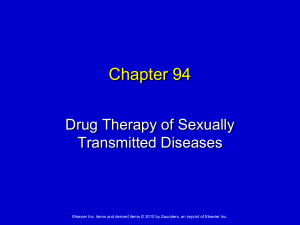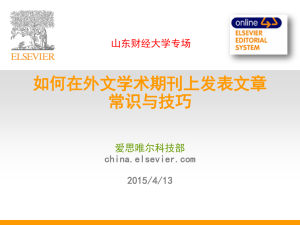Chapter_100
advertisement
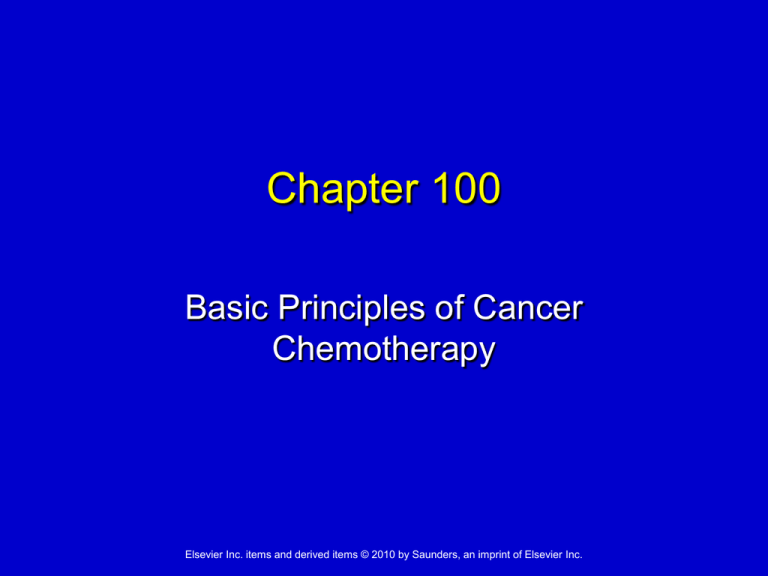
Chapter 100 Basic Principles of Cancer Chemotherapy Elsevier Inc. items and derived items © 2010 by Saunders, an imprint of Elsevier Inc. Elsevier Inc. items and derived items © 2010 by Saunders, an imprint of Elsevier Inc. 2 Cancers Most common cancers Solid tumors of the breast, lung, prostate, colon, and rectum Low growth fraction and respond poorly to drugs Rarer cancers Lymphocytic leukemia, Hodgkin’s disease, certain testicular cancers High growth fraction and respond well to drugs Elsevier Inc. items and derived items © 2010 by Saunders, an imprint of Elsevier Inc. 3 Basic Principles of Cancer Chemotherapy Cancer – unregulated cellular proliferation Treatment modalities Surgery Radiation Drug therapy • Treatment of choice for disseminated cancers (leukemia, disseminated lymphomas, wide-spread metastases) Elsevier Inc. items and derived items © 2010 by Saunders, an imprint of Elsevier Inc. 4 Basic Principles of Cancer Chemotherapy Drug classes Cytotoxic agents Hormones and hormone antagonists Biologic response modifiers Targeted drugs Elsevier Inc. items and derived items © 2010 by Saunders, an imprint of Elsevier Inc. 5 Characteristics of Neoplastic Cells Persistent proliferation Invasive growth Formation of metastases Immortality Etiology of cancer Elsevier Inc. items and derived items © 2010 by Saunders, an imprint of Elsevier Inc. 6 The Growth Fraction and Its Relationship to Chemotherapy The cell cycle Four major phases The growth fraction Impact of tissue growth fraction on responsiveness to chemotherapy Elsevier Inc. items and derived items © 2010 by Saunders, an imprint of Elsevier Inc. 7 Fig. 100-1. The cell cycle. Elsevier Inc. items and derived items © 2010 by Saunders, an imprint of Elsevier Inc. 8 Tissue Growth and Chemotherapy Chemotherapy drugs are more toxic to tissue with high growth fraction Bone marrow Skin Hair follicles Sperm Gastrointestinal tract Elsevier Inc. items and derived items © 2010 by Saunders, an imprint of Elsevier Inc. 9 Obstacles to Successful Chemotherapy Toxicity to normal cells Cure requires 100% cell kill Kinetics of drug-induced cell kill Host defenses contribute little to cell kill When should treatment stop? Elsevier Inc. items and derived items © 2010 by Saunders, an imprint of Elsevier Inc. 10 Fig. 100-2. Gompertzian tumor growth curve showing the relationship between tumor size and clinical status. Elsevier Inc. items and derived items © 2010 by Saunders, an imprint of Elsevier Inc. 11 Obstacles to Successful Chemotherapy Absence of truly early detection Solid tumors respond poorly Drug resistance Heterogeneity of tumor cells Limited drug access to tumor cells Elsevier Inc. items and derived items © 2010 by Saunders, an imprint of Elsevier Inc. 12 Strategies for Achieving Maximum Benefits from Chemotherapy Intermittent chemotherapy Combination chemotherapy Benefits of drug combinations Suppression of drug resistance Increased cancer cell kill Reduced injury to normal cells Optimizing dosing schedules Elsevier Inc. items and derived items © 2010 by Saunders, an imprint of Elsevier Inc. 13 Fig. 100-3. Recovery of critical normal cells during intermittent chemotherapy. Cancer cells and normal cells (eg, cells of the bone marrow) are killed each time drugs are given. In the interval between doses, both types of cells proliferate. Because, in this example, normal cells repopulate faster than the cancer cells, normal cells are able to recover entirely between doses, whereas regrowth of the cancer cells is only partial. As a result, with each succeeding round of treatment, the total number of cancer cells becomes smaller, whereas the number of normal cells remains within a tolerable range. Note that differential loss of malignant cells is possible only if these cells repopulate more slowly than the normal cells. If cancer cells grow back as fast as normal cells do, intermittent chemotherapy will fail. Elsevier Inc. items and derived items © 2010 by Saunders, an imprint of Elsevier Inc. 14 Strategies for Achieving Maximum Benefits from Chemotherapy Regional drug delivery Intra-arterial Intrathecal Other specialized routes Elsevier Inc. items and derived items © 2010 by Saunders, an imprint of Elsevier Inc. 15 Major Toxicities of Cancer Chemotherapy Bone marrow suppression Neutropenia Thrombocytopenia Anemia Digestive tract injury stomatitis Nausea, vomiting, diarrhea Elsevier Inc. items and derived items © 2010 by Saunders, an imprint of Elsevier Inc. 16 Major Toxicities of Cancer Chemotherapy Alopecia Hyperuricemia Reproductive toxicity Local injury from extravasation of vesicants Unique toxicities Carcinogenesis Elsevier Inc. items and derived items © 2010 by Saunders, an imprint of Elsevier Inc. 17 Making the Decision to Treat Benefits of treatment must outweigh the risks Patient must be given some idea of the benefits of proposed therapy One of these three should be possible: Cure, prolongation of life, palliation Elsevier Inc. items and derived items © 2010 by Saunders, an imprint of Elsevier Inc. 18
